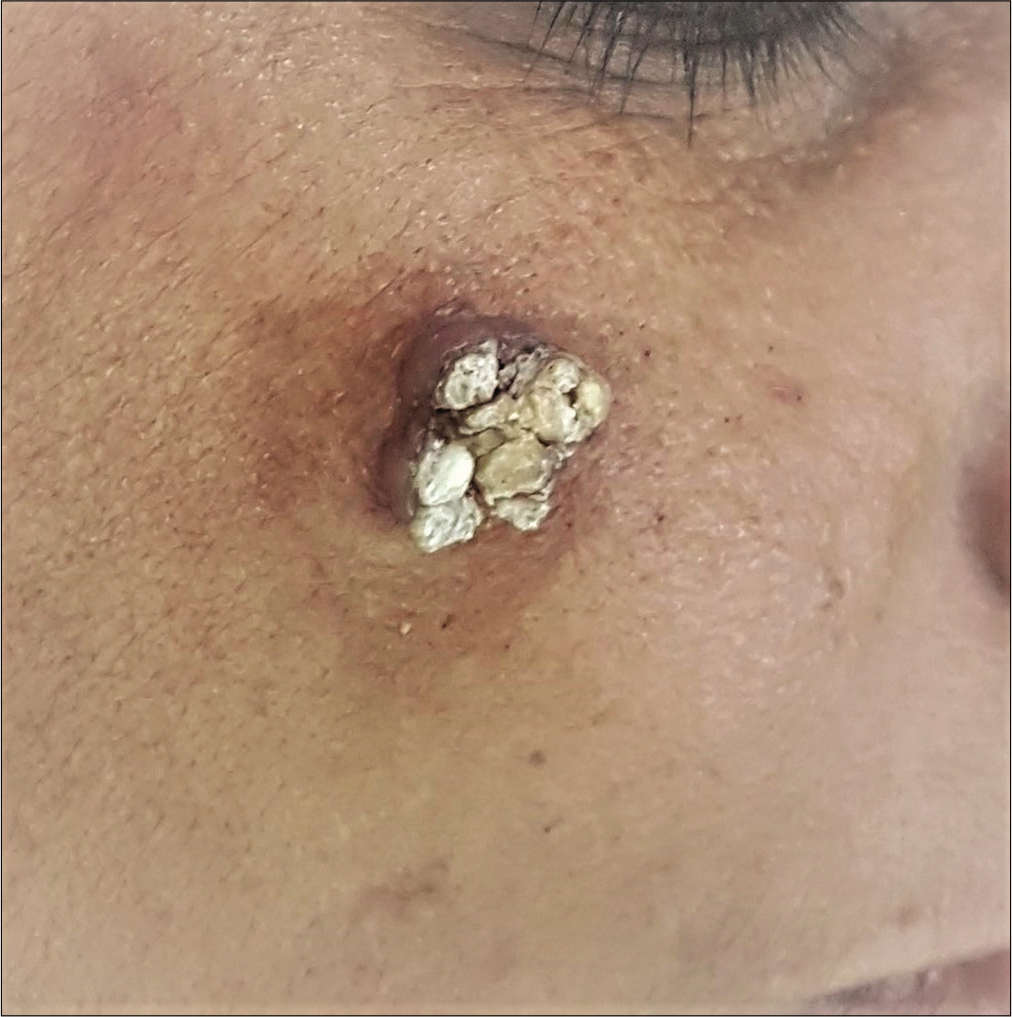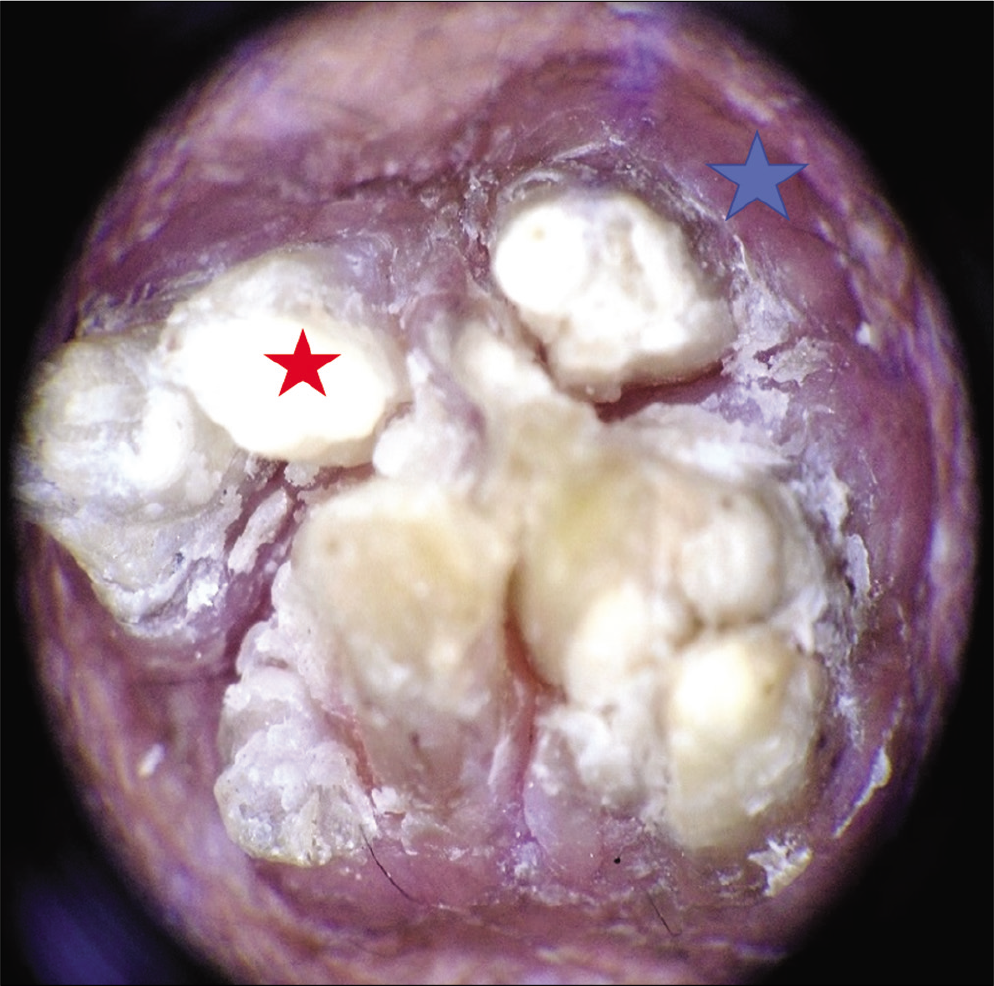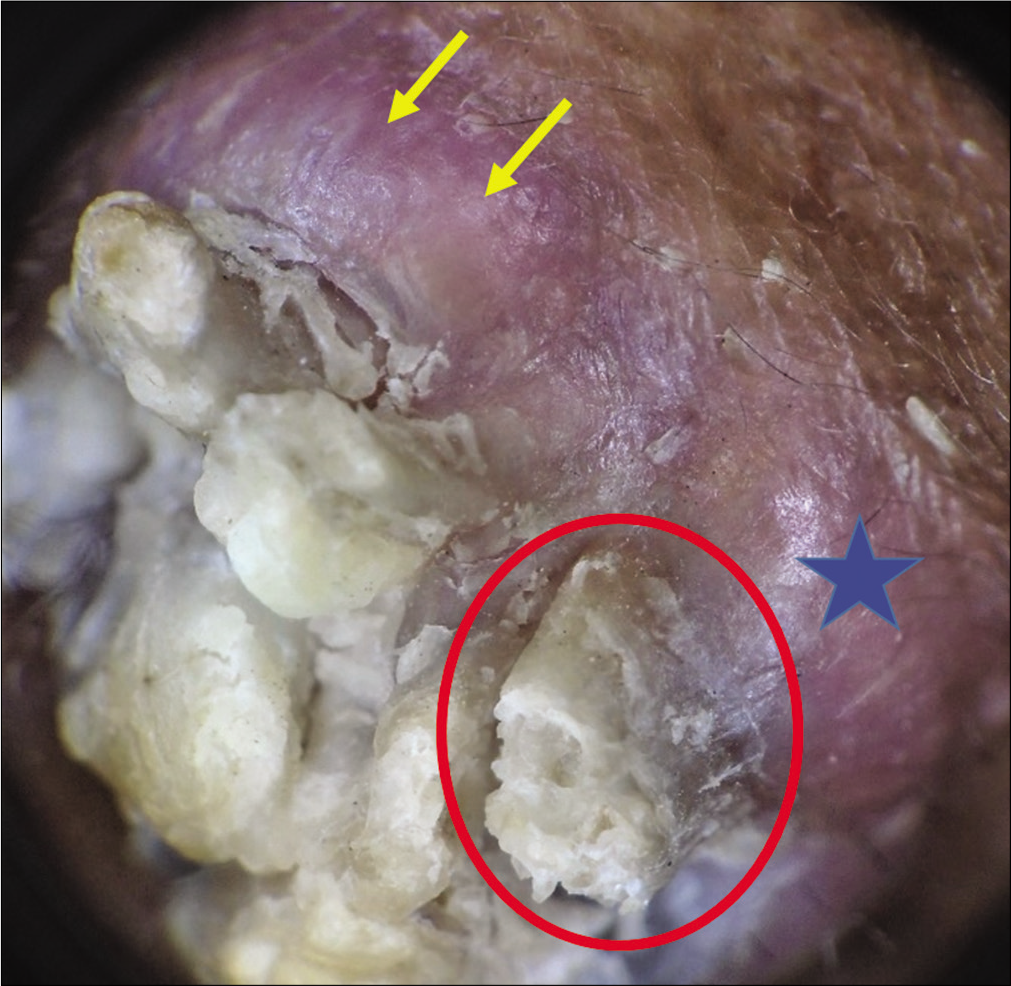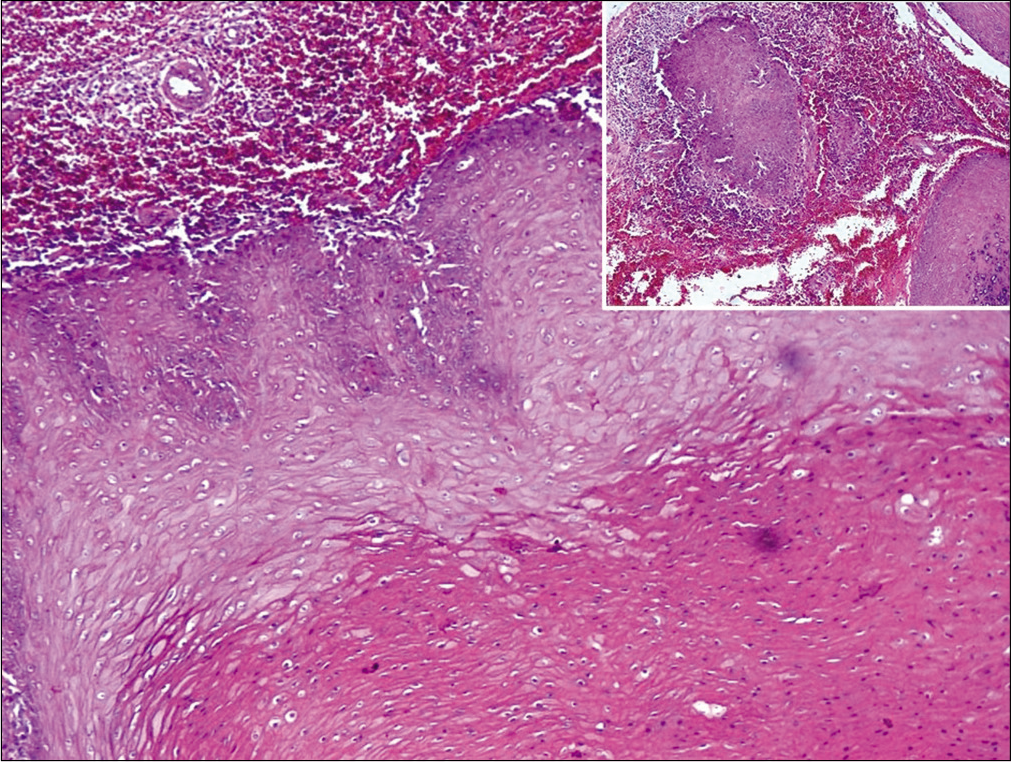Translate this page into:
Cutaneous horn overlying verrucous carcinoma on face and its dermoscopic characterization
Corresponding author: Prof. Archana Singal, Department of Dermatology and STD, University College of Medical Sciences and GTB Hospital(University of Delhi), New Delhi -110 095, India. archanasingal@hotmail.com
-
Received: ,
Accepted: ,
How to cite this article: Singal A, Agrawal S, Gogoi P. Cutaneous horn overlying verrucous carcinoma on face and its dermoscopic characterization. Indian J Dermatol Venereol Leprol 2021;87:388-90.
Sir,
Cutaneous horns, also known as cornu cutaneum, are conical protrusions composed of cornified material derived from the basal keratinocytes. They are generally solitary and have predilection for sun-exposed areas like face, scalp, eyelids, neck and forearms.1 The underlying pathology could be benign (41 to 60% cases), premalignant or malignant. The associated lesions at the base include squamous cell carcinoma, viral warts, actinic keratosis, keratoacanthoma, Bowen’s disease, seborrheic keratosis, basal-cell carcinoma and Kaposi sarcoma. Other less common lesions are epidermal nevus, ichthyosis hystrix, verruca vulgaris, actinic keratosis, other precancerous keratosis, seborrheic keratosis, molluscum contagiosum, trichilemmal cysts or epidermoid cysts.2,3 Malignant transformation into squamous cell carcinoma has been reported to occur in around 20 to 25% of cases.3 The diagnosis is clinical but histopathology is important to identify the underlying lesion. Dermoscopy is a noninvasive office procedure with ever-expanding indications in dermatology in the diagnosis of both pigmented and nonpigmented lesions. Dermoscopic features of cutaneous horn with varying underlying lesions have not been studied enough. We hereby present a case of cutaneous horn with underlying rare pathology of verrucous carcinoma and describe its dermoscopic findings.
A 65-year-old woman presented to the dermatology outpatients of UCMS and GTB hospital, Delhi, with solitary, tender, slowly progressive, hyperkeratotic lesion of 2 × 2 cm size on the right cheek of 3 years duration. The lesion was composed of multiple, closely set whitish hard projections arising from an erythematous, indurated crateriform base [Figure 1]. There was no regional lymphadenopathy. She was thin built but her physical examination otherwise was within normal limits. Her routine hematological and biochemical investigations revealed no abnormality. Polarizing dermoscopy (DermLite DL3; 10X) showed [Figures 2a and b] multiple, closely set off-white colored structures (conical projections) over a dull red colored background; the height of the conical projections was less than that of the base. Dermoscopy on the periphery of lesion showed an absence of structural horizontal contours (i.e., absent terrace phenomenon). This dull red colored background did not reveal any specific vascular morphology and pattern. Follicular scales were visible at the periphery of the lesion. These dermoscopic findings pointed towards an underlying malignant lesion. With this background, an excision biopsy with a 5-mm margin was performed with the clinical diagnosis of cutaneous horn probably with underlying malignant lesion. The biopsy on hematoxylin and eosin stained sections revealed mounds of parakeratosis, acanthosis with koilocytic changes suggestive of human papilloma virus (HPV) infection and downward papillomatous growth of the rete ridges surrounded by dense collection of lymphocytes, indicating an invasive pathology of verrucous carcinoma [Figure 3]. The margins of the excised specimen were free of carcinoma. The cosmetic outcome was very good.

- Cornified lesion of cutaneous horn on right cheek

- Multiple closely set off-white colored structures (red star) over a dull red colored background (blue star)

- Side view of the horn (in red circle) showing the absence of structural horizontal contours (absent terrace phenomenon) and no specific vascular morphology and pattern in the background (blue star). Also, note the follicular scales (yellow arrow) (polarizing dermoscopy ×10)

- The epidermis showing mounds of parakeratosis, acanthosis with koilocytosis and papillomatous rete ridges suggestive of invasive pathology (H&E, ×100). Inset shows dense lymphocytic infiltrate around the bulbous rete ridges
The present case unfolded the presence of verrucous carcinoma at the base of a cutaneous horn. Verrucous carcinoma (Ackerman’s tumor) is a well-differentiated warty variant of squamous cell carcinoma with low malignant potential. It typically involves the oral cavity, esophagus, larynx, genitalia and plantar surface of foot. Face is not a common site.4 Strong association with tobacco and betel nut chewing and HPV infection has been documented. There is a single study by Pyne et al. evaluating the dermoscopic features of cutaneous horn in 163 consecutive patients.5 The authors concluded that few dermoscopic features are significantly associated with underlying invasive SCC namely low height-to-base ratio, absence of terrace morphology and presence of base erythema and tenderness. They recorded lower height of the horn as compared to the diameter of the base in 67% cases of invasive squamous cell carcinoma. On the contrary, height of the horn was greater than base diameter in benign keratosis. All these features were seen in our patient. Terrace morphology is a feature presenting as structural horizontal contours on the side of the horn. On histopathology, it appears as ortho-hyperkeratosis with horizontal parallel lamellae of dead keratin. Base erythema is characterized by presence of red area within 5 mm of horn base that may be attributed to the increased perfusion. The close dermoscopic differentials include actinic keratosis, benign keratosis and SCC in situ. The differentiating dermoscopic features of cutaneous horn with underlying benign and malignant etiology have been tabulated in Table 1.
| Feature | Benign horn | Malignant horn |
|---|---|---|
| Horn height: diameter of base | Horn height more than the diameter of base | Horn height less than base diameter |
| Terrace morphology | Present | Absent |
| Base erythema | Less | More |
| Pain on palpation | Less | More |
Thus, cutaneous horns could be a harbinger of malignancy as seen in our case. Though histopathology remains the diagnostic gold standard, dermoscopy can offer a clue to the underlying malignant etiology and affect the decision of therapeutic and diagnostic surgical excision.
Declaration of patient consent
The authors certify that they have obtained all appropriate patient consent.
Financial support and sponsorship
Nil.
Conflicts of interest
There are no conflicts of interest.
References
- Cutaneous horns: Are these lesions as innocent as they seem to be? World J Surg Oncol. 2004;2:18.
- [CrossRef] [PubMed] [Google Scholar]
- A histopathological study of 643 cutaneous horns. Br J Dermatol. 1991;124:449-52.
- [CrossRef] [PubMed] [Google Scholar]
- Cutaneous horn: A retrospective histopathological study of 222 cases. An Bras Dermatol. 2010;85:157-63.
- [CrossRef] [PubMed] [Google Scholar]
- Verrucous carcinoma in a giant cutaneous horn: A case report and literature review. Case Rep Otolaryngol. 2020;2020:7134789.
- [CrossRef] [PubMed] [Google Scholar]
- Cutaneous horns: Clues to invasive squamous cell carcinoma being present in the horn base. Dermatol Pract Concept. 2013;3:3-7.
- [CrossRef] [PubMed] [Google Scholar]





